Direct Connection Adaptivity
SKEDD direct connection technology makes device design more flexible
Pia Horstmann, Product Marketing for PCB Connection Technology, Phoenix Contact GmbH & Co. KG, Blomberg, Germany
James Dunbar, Product Marketing Manger for PCB Connection Technology, Phoenix Contact USA, Middletown, Pa., USA
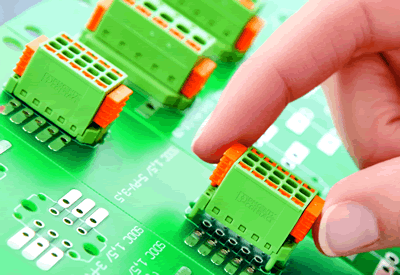
SKEDD direct connection technology brings new flexibility to device design.
Intelligent automation structures, such as HVAC systems in building technology or compact controllers in industrial applications, require functionally embedded systems. This poses a challenge to device manufacturers to develop universally operational solutions for specific tasks and ambient conditions. SKEDD direct connection technology is the next innovation in PCB connection technology (Figure 1).
Increased device flexibility — that is to say, adaptability — means that fewer versions need to be produced and made available, and overall unit costs are lower. PCBs and connection components are the central nervous system of electronics and, as such, have a large impact on the performance and flexibility of electrical devices.
More flexibility thanks to SKEDD technology
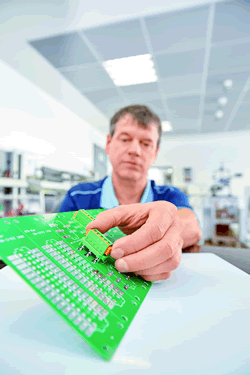
Figure 1: The first direct connector in the world with push-in spring connection allows application-specific device designs with just a few PCB layouts.
The innovative direct connection technology SKEDD, which is Swedish for “it is done,” makes direct pluggable and detachable PCB connections at any position on the PCB possible for the first time. New PCB connectors featuring SKEDD technology eliminate the need for headers. They can be plugged directly onto the PCB by hand, via tin-plated through-holes. The advantage: In the past, electronics manufacturers needed to combine application-specific connection technology, such as PCB terminal blocks or headers, with the PCB using a permanent soldering process. This largely dictated functionality of the PCB and the overall device. SKEDD direct connection technology makes this process unnecessary, as only the corresponding plated through-holes need to be provided in the PCB manufacturing process. In this way, the PCB does not become thermally loaded again.
Currently, many PCBs are processed first in a SMD reflow solder method, and PCB terminal blocks or headers are soldered on as the second step in a wave soldering process. Eliminating the second soldering process effectively reduces process and component costs and makes all logistics and materials planning for the headers unnecessary. It also reduces equipment costs and feeder space requirements when using the SMD soldering process. When the header is eliminated from the board, there is more space for additional components. In an ideal case, additional modules can even be produced on a single system without conversion.
Reliable mechanical connection
Both PCB and device manufacturers can see immediate benefits from this technology. In addition to saving costs, they can now use a single PCB layout for different device designs and still implement flexible application-specific connections for signal, data, or power transmission (Figure 2).
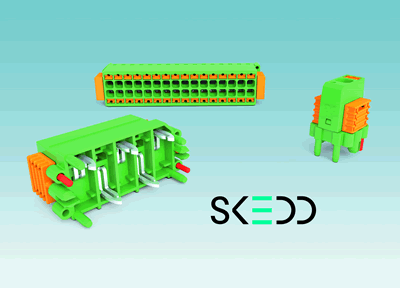
Figure 2: Single- and double-row direct connectors offer solutions for countless applications, such as climate control systems, smoke and fire alarms, and large household appliances.
SKEDD contacts are an improvement on press-in technology, and they place no special requirements on the PCB. The contact zone consists of two flexible contact members that are easy to bend outward and are optimally adapted to PCB plated-through holes. When inserting the contact into the plated through-hole, the contact members are pressed together, thereby ensuring a secure mechanical and electrical connection. Lateral body-bound rivets on the connector also increase the mechanical stability. The interlock is designed for standard PCBs with a thickness of 0.063” and allows for up to 25 mating/unmating cycles (Figure 3).
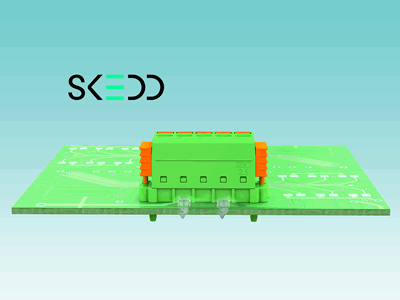
Figure 3: SKEDD contacts consist of two flexible contact limbs that are easy to bend outward and are optimally adapted to plated-through bore holes.
Tested in accordance with railway equipment and household appliance standards
In addition to the required approval and qualification tests, SKEDD direct connectors meet the highest requirements of mechanical and electrical safety. For example, both single- and double-row SKEDD connectors are qualified for special fire protection requirements in accordance with DIN EN 60335-1 (Household and Similar Electrical Appliances – Safety – Part 1 – General Requirements). This standard includes household appliances including: dishwashers, washing machines, and portable cooking appliances, drives for awnings and blinds, heating units, climate systems, and heating and cooling circulation pumps in private and commercial areas.
Two tests prove the capability of the electrical components and the polyamide insulating material used. First, a glow-wire with a temperature of 850°C is applied to the material for 30 seconds. The Glow-Wire Flammability Index (GWFI) test is successfully passed if the test plate continues to glow for less than 30 seconds after removing the glow-wire. The second test establishes the glow-wire ignition temperature (GWIT). For this test, a glow-wire with a temperature of 775°C is held to the plastic test plate. To pass, the material may glow briefly, but for less than five seconds, and it may not ignite.
Single-row connectors are also qualified and approved for PCBs with hot air levelling (HAL) surface protection in accordance with DIN EN 61373 (Railway Applications – Rolling Stock Equipment – Shock and Vibration Tests). These standards place high demands on the vibration-proof and shock-proof capabilities of devices and components used in trains. For this test, the connectors were exposed to 15 hours — five hours per spatial axis — of random vibrations with a frequency of 1–150Hz and an effective acceleration of up to 5.72m/s². Interruption of the contact may not exceed 1µs during this process.
A wide range of solutions
The standardized tests attest to how reliable the direct connection technology functions, even under demanding ambient conditions and high safety requirements. SKEDD direct connectors are suited for classic industrial applications, as well as for applications in building automation and railway technology.
SKEDD PCB connectors offer solutions for countless applications, such as climate control in rail vehicles, smoke and fire alarms, and large household appliances. Both series feature tool-free push-in spring connection, which means that both solid and stranded conductors with ferrules can be connected without opening the spring interface. The integrated test points also enable convenient function checks when loaded. Designed for conductor cross-sections up to 12AWG, the single-row direct connectors are suited for currents up to 320V. The double-row connectors offer an efficient connection solution ideal for signal densities that are often high in measuring, control, and regulation technology (Figure 4).
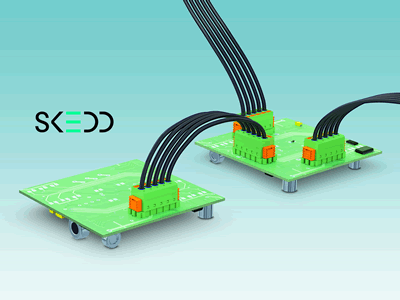
Figure 4: SKEDD direct connectors are suited for connections on the bottom of the PCB or for internal device wiring
The advantages at a glance
- Flexible positioning on the PCB
- Easy to plug in by hand and create vibration-proof connection
- Reduced component and process costs
- Tool-free, time-saving connections with push-in technology
- Intuitive operation, thanks to color-coded push button
- Quick and convenient testing using integrated testing option
- Single- and double-row designs for up to 32 connection positions
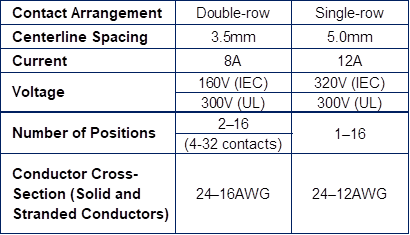
Summary
The combination of push-in spring connection and SKEDD direct connection technology offers new flexibility in device wiring with tool-free, reliable, and process-efficient performance. SKEDD connectors do not require headers and can be plugged in directly by hand in tin-plated through-holes. This enables PCB and device manufacturers to implement countless device designs with application-specific connections for signal, data, and power using just a few PCB layouts. Various tests have proven it: Whether for applications with high-vibration requirements, like railway technology, or with special fire protection requirements, like in household device technology, direct connectors with SKEDD technology are a useful new solution.
For more information, visit www.phoenixcontact.com/skedd.
Recently posted:
[related_posts limit=”10″]






